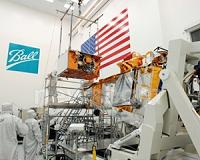 |
Southhapton UK (SPX) Feb 18, 2011 The world's first control system that will allow engineers to programme autonomous satellites and spacecraft to think for themselves has been developed by scientists from the University of Southampton. Professor Sandor Veres and his team of engineers have developed a cognitive software agent control system called 'sysbrain'. Using natural language programming (NLP), the software agents can read special English language technical documents on control methods. This gives the vehicles advanced guidance, navigation and feedback capabilities to stop them crashing into other objects, agent-based control with mission execution capabilities and the ability to recognise and reconfigure faults. Professor Veres, who is leading the EPSRC-funded project, says: "This is the world's first publishing system of technical knowledge for machines and opens the way for engineers to publish control instructions to machines directly. "As well as spacecrafts and satellites, this innovative technology is transferable to other types of autonomous vehicles, such as autonomous underwater, ground and aerial vehicles." To test the control systems that could be applied in a space environment, Professor Veres and his team constructed a unique test facility and a fleet of satellite models, which are controlled by the sysbrain cognitive agent control system. The 'Autonomous Systems Testbed' consists of a glass covered precision level table, surrounded by a metal framework, which is used to mount overhead visual markers, observation cameras and isolation curtains to prevent any external light sources interfering with experimentation. Visual navigation is performed using onboard cameras to observe the overhead marker system located above the test area. This replicates how spacecraft would use points in the solar system to determine their orientation. The perfectly-balanced model satellites, which rotate around a pivot point with mechanical properties similar to real satellites, are placed on the table and glide across it on roller bearings almost without friction to mimic the zero-gravity properties of space. Each model has eight propellers to control movement, a set of inertia sensors and additional cameras to be 'spatially aware' and to 'see' each other. The model's skeletal robot frame also allows various forms of hardware to be fitted and experimented with. Professor Veres adds: "We have invented sysbrain to control intelligent machines. Sysbrain is a special breed of software agents with unique features such as natural language programming to create them, human-like reasoning, and most importantly they can read special English language documents in 'system English' or 'sEnglish'. Human authors of sEnglish documents can put them on the web as publications and sysbrain can read them to enhance their physical and problem solving skills. This allows engineers to write technical papers directly for sysbrain that control the machines."
Share This Article With Planet Earth
Related Links SESNET Project at University of Southampton Space Technology News - Applications and Research
 NASA's NPP Satellite Undergoing Flight Environmental Testing
NASA's NPP Satellite Undergoing Flight Environmental TestingGreenbelt MD (SPX) Feb 14, 2011 The NASA National Polar-orbiting Operational Environmental Satellite System (NPOESS) Preparatory Project (NPP) climate/weather satellite is undergoing flight environmental testing at Ball Aerospace and Technologies Corp's production and test facility in Boulder, Colo. The NPP satellite began environmental testing in November 2010 and has successfully completed vibration, acoustics and shoc ... read more |
|
| The content herein, unless otherwise known to be public domain, are Copyright 1995-2010 - SpaceDaily. AFP and UPI Wire Stories are copyright Agence France-Presse and United Press International. ESA Portal Reports are copyright European Space Agency. All NASA sourced material is public domain. Additional copyrights may apply in whole or part to other bona fide parties. Advertising does not imply endorsement,agreement or approval of any opinions, statements or information provided by SpaceDaily on any Web page published or hosted by SpaceDaily. Privacy Statement |